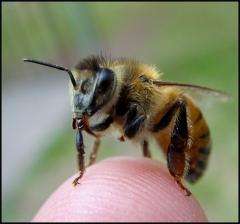The bee's knees for identifying genetic triggers of novel adult traits

Scientists have long sought to identify the specific DNA changes that can trigger new traits, allowing species to adapt. But when animals develop a new trait, are the mutations within the part of the DNA that makes proteins, or, in the master switches that control the gene, modulating its activity to turn on or off?
For development of the embryo, it is usually the master control regions of a gene that dominate, but what about in an adult?
Jasper et al. found that adults play by a different set of rules, relying on the contributions of novel genes—-called taxonomically restricted genes (TRGs, that are only found in a given species)—-found in honeybees. Honeybees possess many new adult traits to complement social functions, such as glands to make pheromones for social communication, food for young bees, sting glands to protect the hive, and a division of labor. For the study, they focused on nurse bees that eat pollen to make secretions to feed the brood, and foragers, who sprout wings to take flight. They looked at patterns of genes found in 10 tissues that change in the adult bee when transitioning from nursing to foraging.
"We essentially found that the evolution of novel adult traits is strongly based on changes to the protein coding parts of genes," said paper co-author Brian Johnson. "Specifically, the key genes are often those that are expressed in just one tissue at a very high level. Such genes are often novel, that is organism-specific as opposed to common to all animals, and they provide much of the specialized work of the various tissues of the adult organism. Ironically, although this result contrasts sharply with the highly successful Evo-devo paradigm, we generated our hypotheses in part using the same logical framework developed by the Evo-devo researchers. This framework stresses the importance of connectedness in a gene network and how that hinders (or allows) various types of DNA sequence change."
In fast-evolving tissues, they found evidence that TRGs are critical and much more abundant, underlying novel phenotypes by rapidly mutating their protein-coding DNA sequence to perform new cellular functions. Likewise, they did not find TRGs expressed in "old" tissues. These genes were also the least connected ingene networks, allowing them the freedom to develop novelty for the bees, without having a negative effect on survival. This supports their theory that the evolution of novel adult physiological traits occurs in the distal branches of gene networks rather than hubs (unlike in the embryo), making them more free to develop gene changes for new functions as needed.
Provided by Oxford University Press



















